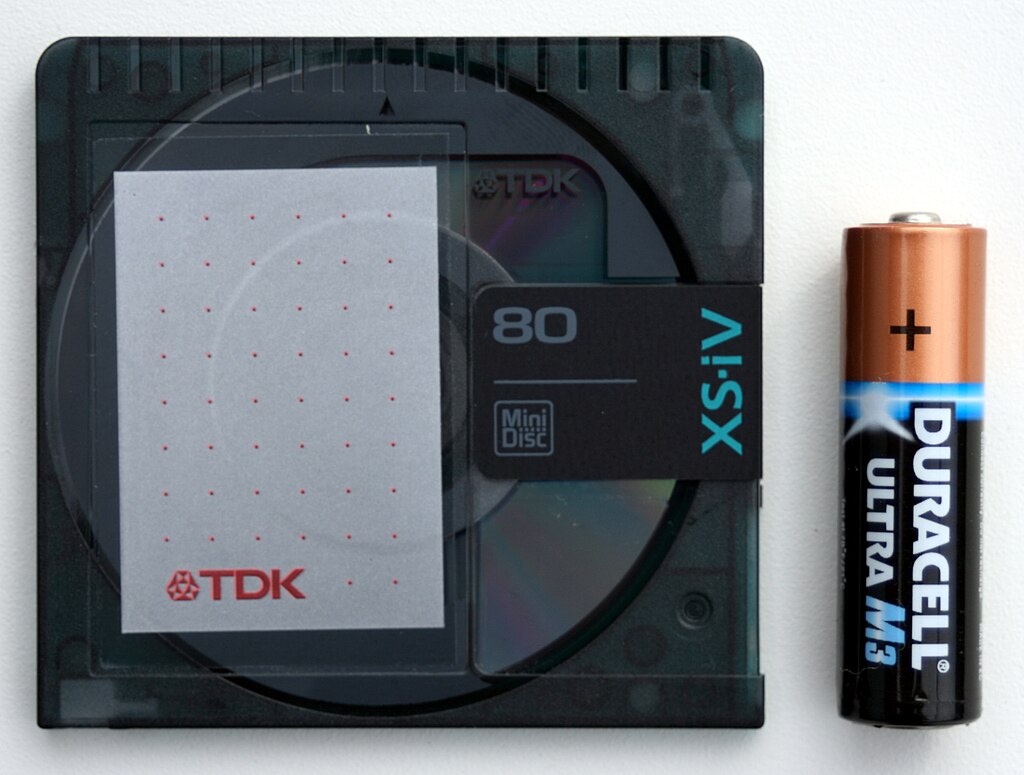(Creative Commons Attribution-Share Alike 3.0 Unported License Information)
I got inspired to write this article when I found a box in the back of my mom’s closet full of minidiscs, a minidisc recorder and player. The small metal square fit almost perfectly in my hand and the discs that went inside it were even smaller, and on top of that were trapped inside of hard plastic squares. I absolutely adored the look of these things and had to learn more about them.
Portable music has seen a lot of phases before getting to where we are today. CDs, cassettes, and mp3 players are all formats you’re probably familiar with. One format you may be less familiar with is the minidisc.
Released by Sony in 1992, the minidisc format was meant to supplant cassettes. Cassettes had the benefit of being massively re-recordable but suffered from several major flaws. The first of these flaws was audio quality. The audio quality of cassette tapes was terrible in comparison to CDs. The other major flaw was that they were very flimsy and broke easily. The minidisc was meant to combat these problems. Minidiscs could be recorded over and over again, were sturdy, and had audio quality that would eventually get to be comparable to the quality found on CDs.
So… why aren’t they around anymore? While yes, they are still technically around and there are dedicated minidisc collectors, they are no longer produced. Sony stopped producing minidisc players in 2013, and announced in January of this year that they would be ending the production of the minidiscs themselves. In February of 2025, they officially stopped production.
Minidiscs never took off in the United States. They found success in Japan and were moderately successful in certain parts of Europe. Like all failed products, the reasons for this were multifaceted. One of the major problems was that there were almost no official releases. Almost all minidiscs sold were blank, with the intention that they would be loaded with music by the consumer. Compared to CDs, which were supported by big names, there was little incentive for anyone other than Sony to market the product. Labels and artists alike had reasons to promote CDs, but no such reason existed for the minidisc.
Another major problem was the price. Minidisc recorders were around $800 dollars, which made them largely inaccessible for most consumers. The demographic that had some of the least disposable income to spend on all the machinery required for getting started with minidiscs were teenagers. As most people reading this know very well, teenagers are an absolutely massive demographic for music consumption. Most people who work at WKNC were teenagers only a few years ago, and can vouch for this point. Buying the required equipment for a minidisc was equivalent to buying forty $20 CDs by bands they already liked that they could play on CD players they already owned. From this standpoint, minidiscs weren’t worth it and were extremely inaccessible.
So it failed because of price and lack of adoption by the music industry, but what else? Yes, there were even more reasons for the minidisc to fail. Shortly after the release of the minidisc, the CD-R was released. CD-Rs were blank CDs that anyone could easily record audio onto. While it didn’t have the rewritability of minidiscs, the price was super accessible and the technological know-how was minimal.
Although the minidisc technically had more options, from rewritability, to ability to select a specific song while listening, to fun little headphones that came with built in remotes, it still lost. New technology came out at a pace that far outmatched the minidisc’s ability to keep up.
Despite all their problems, I wish that minidiscs had been given more of a chance. They are so fun to use, and I am really intrigued by them. Unfortunately, one college kid being invested in an obsolete music format does not make it a suddenly become a viable piece of technology.

